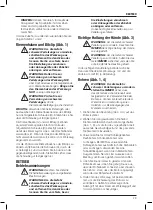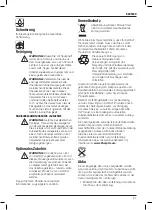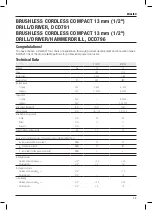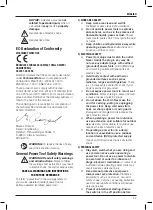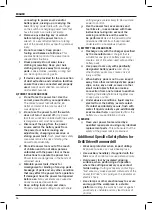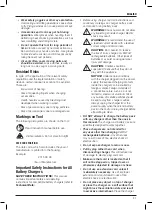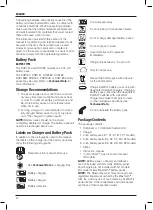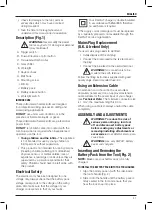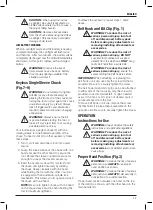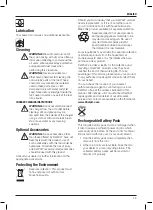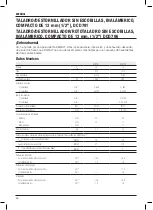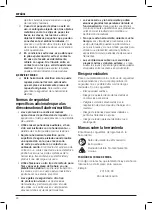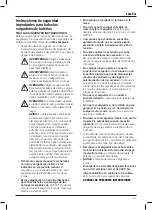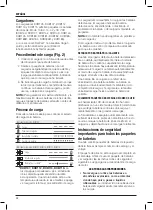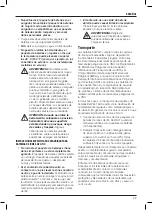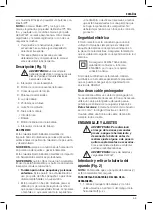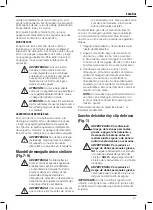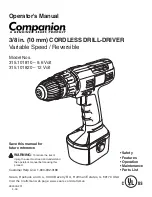
42
english
Torque Adjustment Collar (Fig. 1)
Your tool has an adjustable torque screwdriver
mechanism for driving and removing a wide array
of fastener shapes and sizes and in some models,
a hammer mechanism for drilling into masonry.
Circling the collar (C) are numbers, a drill bit symbol,
and in some models, a hammer symbol. These
numbers are used to set the clutch to deliver a
torque range. The higher the number on the collar,
the higher the torque and the larger the fastener
which can be driven. To select any of the numbers,
rotate until the desired number aligns with the arrow.
NOTE:
The torque adjustment collar is only
engaged during screwdriving mode and not in drill
and hammerdrill modes.
Dual Range Gearing (Fig. 1)
The dual range feature of your drill/driver allows you
to shift gears for greater versatility.
1. To select speed 1 (high torque setting), turn
the tool off and permit it to stop. Slide the gear
shifter (D) forward (towards the chuck).
2. To select speed 2 (low torque setting), turn the
tool off and permit it to stop. Slide the gear
shifter back (away from the chuck).
NOTE:
Do not change gears when the tool
is running. Always allow the drill to come to a
complete stop before changing gears. If you are
having trouble changing gears, make sure that the
dual range gear shifter is either completely pushed
forward or completely pushed back.
LED Worklight (Fig. 1)
The LED worklight (E) and its worklight switch (L)
are located on the foot of the tool. The worklight is
activated when the trigger switch is depressed. The
low (M), medium (N) and spotlight (O) modes can
be changed by moving the switch on the foot of the
tool. If the trigger switch remains depressed, the
worklight will remain on in all modes.
When on low (M) and medium (N) settings, the
beam will automatically turn off 20 seconds after the
trigger switch is released.
SPOTLIGHT MODE
The high setting (O) is the spotlight mode. The
spotlight will run for 20 minutes after the trigger
switch is released. Two minutes before the spotlight
will shut off, it will flash twice and then dim. To
avoid the spotlight shutting off, lightly tap the trigger
switch.
WARNING:
While using the worklight in
medium or spotlight mode, do not stare
at the light or place the drill in a position
which may cause anyone to stare into
the light. Serious eye injury could result.
TO REMOVE THE BATTERY PACK FROM THE TOOL
1. Press the release buttons (K) and firmly pull the
battery pack out of the tool handle.
2. Insert battery pack into the charger as
described in the charger section of this manual.
FUEL GAUGE BATTERY PACKS (FIG. 2)
Some
D
e
WALT
battery packs include a fuel gauge
which consists of three green LED lights that
indicate the level of charge remaining in the battery
pack.
To actuate the fuel gauge, press and hold the fuel
gauge button (P). A combination of the three green
LED lights will illuminate designating the level of
charge left. When the level of charge in the battery
is below the usable limit, the fuel gauge will not
illuminate and the battery will need to be recharged.
NOTE:
The fuel gauge is only an indication of the
charge left on the battery pack. It does not indicate
tool functionality and is subject to variation based
on product components, temperature and end-user
application.
Variable Speed Trigger Switch (Fig. 1)
To turn the tool on, squeeze the trigger switch (A).
To turn the tool off, release the trigger switch. Your
tool is equipped with a brake. The chuck will stop
as soon as the trigger switch is fully released.
NOTE:
Continuous use in variable speed range is
not recommended. It may damage the switch and
should be avoided.
Forward/Reverse Control Button
(Fig. 1)
A forward/reverse control button (B) determines the
direction of the tool and also serves as a lock-off
button.
To select forward rotation, release the trigger switch
and press the forward/reverse control button on
the right side of the tool.
To select reverse, press the forward/reverse control
button on the left side of the tool.
The centre position of the control button locks
the tool in the off position. When changing the
position of the control button, be sure the trigger is
released.
NOTE:
The first time the tool is run after changing
the direction of rotation, you may hear a click on
start up. This is normal and does not indicate a
problem.


